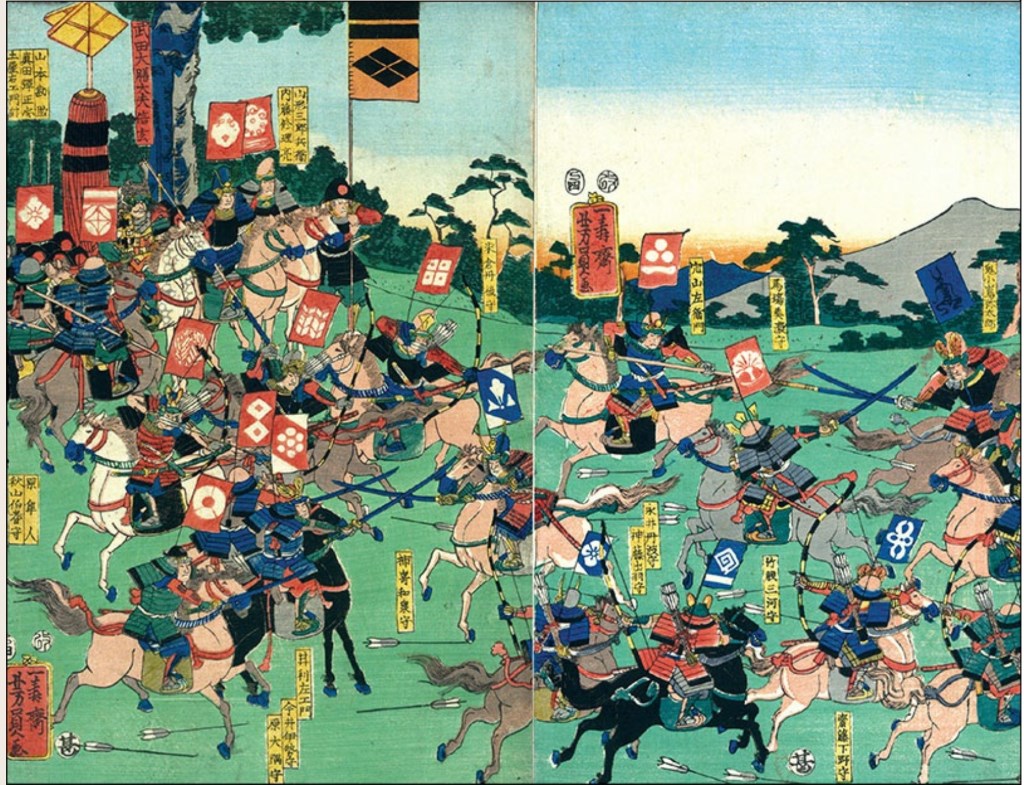
The Battle of Kawanakajima was an annual event fought
between Uesugi Kenshin and Takeda Shingen. Both daimyo would ensure the battle
ended in a draw.
Depiction of the legendary personal conflict between
Kenshin and Shingen at the fourth battle of Kawanakajima.
Two of the early Sengoku Jidai’s most colourful daimyo were
Takeda Shingen and Uesugi Kenshin. They represented the last of the gentlemen
warriors, who conducted their warfare according to the honourable traditions of
old. Every year for five years in a row the armies of Kenshin and Shingen met
in the same place on the plain of Kawanakajima to do battle. Sometimes, when
one army had gained the upper hand it would withdraw as a sign of respect for
the opposition. When Shingen’s salt supply was cut off by Kenshin’s ally, the
Hojo clan, Kenshin sent Shingen a supply of salt from his own stock, commenting
that he `fought with swords, not salt.’
The first half of the fifteenth century in Japan saw
sporadic rebellions taking place, all of which were quelled successfully until
1467, when a quarrel between two samurai houses developed into a military and
political disaster. The resulting Onin War was fought largely around the
capital and even in the streets of Kyoto itself, which was soon reduced to a
smoking wasteland. The shogun at the time was Ashikaga Yoshimasa, Yoshimitsu’s
grandson, who was totally unable to prevent a slide into anarchy. Instead
Yoshimasa contented himself with artistic pursuits, and was one of the early
devotees of the tea ceremony. He also built the Ginkakuji (Silver Pavilion) in
an attempt to emulate his illustrious ancestor. His cultural achievements were
many, but the power of the shogunate declined as never before.
With such a vacuum at the heart of Japanese politics, many
samurai took the opportunity to develop their own local autonomy in a way that
had not been seen for centuries. It was as if the powerful landowners of the
Nara period had been reborn, and throughout Japan there was a scramble for
territory. Some ancient families disappeared altogether to be replaced by men
who had once fought for them and achieved local power through war, intrigue,
marriage, or murder. Other ancient lines prospered, and found themselves having
to share Japan with upstarts who may have started their careers as ashigaru
(foot soldiers) but who now owned a considerable amount of territory, which
they defended using wooden castles and loyal followers. These lords called
themselves daimyo (great names), and led lives that were constantly being
challenged by neighbors. Literally scores of battles took place, leading to the
century and a half between 1467 and 1600 being dubbed the Sengoku Jidai (the
period of Warring States), by analogy with a similar turbulent period in
ancient China.
A good example of the trend was to be found in north-central
Japan where the territories of the Takeda and Uesugi families were located.
They were at war for half a century. Their most famous members, Takeda Shingen
and Uesugi Kenshin, were princes in their own provinces, and led thousands of
fanatically loyal samurai. Takeda Shingen is customarily credited with being
the finest leader of mounted samurai in Sengoku Japan. At Uedahara in 1548 and
at Mikata ga Hara in 1572, the Takeda cavalry rode down disorganized infantry
missile units. But for cavalry charges to succeed, the old samurai tradition of
singling out a worthy opponent for a challenge to single combat had to wait
until the enemy line was broken, so group operations became the norm.
The Takeda and Uesugi fought each other five times at a
place called Kawanakajima (“the island within the river”), a
battlefield that marked the border between their territories. Not only were the
armies the same, the same two commanders led them at each battle. In addition
to this intriguing notion of five battles on one battlefield, Kawanakajima has
also become the epitome of Japanese chivalry and romance: the archetypal clash
of samurai arms.
In its more extreme form, this view even denies the
possibility that anyone actually got hurt at the Kawanakajima battles, which
are seen only as a series of “friendly fixtures” characterized by
posturing and pomp. In this scenario the Kawanakajima conflicts may be
dismissed as mock warfare. During some of the encounters, admittedly, the two
armies disengaged before committing themselves fully to a fight to the death,
but the wounds and the dead bodies were real enough, and the fourth battle of
Kawanakajima in 1561 produced many casualties on both sides.